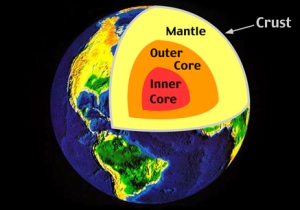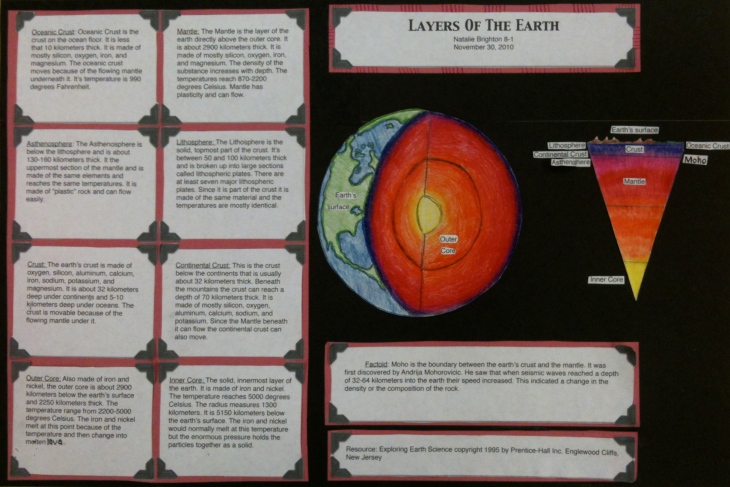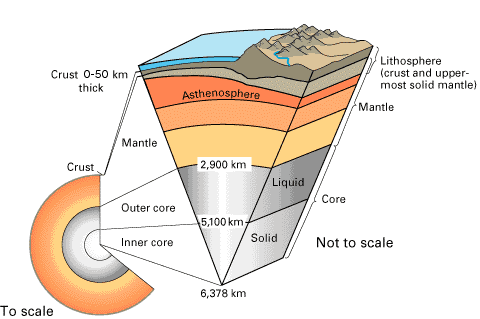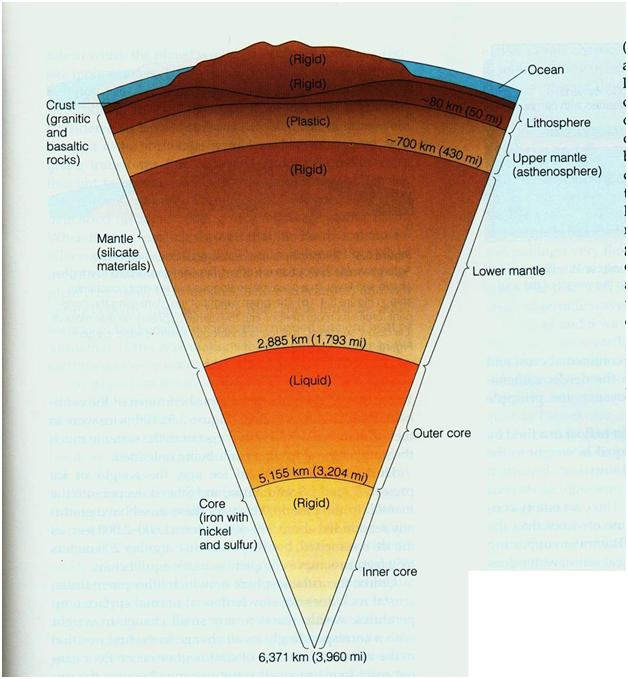OVERVIEW
The Earth is made of layers, each with its own distinct chemical and physical properties. Scientists use earthquakes to study the Earth’s interior.
CONCEPTS
Discuss how scientists study the structure of the Earth’s interior. Recognize that an understanding of the motion of earthquake waves can help scientists formulate hypotheses about the Earth’s interior. Compare and contrast the different layers of the Earth.
MAIN IDEAS
1. Physical Properties (characteristics):
As you travel from the surface of the earth towards the interior:
Temperature increases
Density Increases
Pressure increases
Viscocity decreases
2. Composition (what it’s made of):
Crust: solid rock
Mantle: melted rock
Outer Core: liquid iron
Inner Core: solid iron and nickel
3. Major layers of the Earth (from surface to interior):
Crust Mantle Outer Core Inner Core
4. Plate Movement:
The plates of the lithosphere float on the upper mantle. This part of the mantle is called the asthenosphere. The consistency of the asthenosphere is like silly putty. The asthenosphere is hot, and, like silly putty, it can flow. The movement of the plates of the lithosphere on top of the slowly moving asthenosphere accounts for the formation of many mountains and volcanoes, as well as for earthquakes.
5. Mantle Structure:
The upper mantle structure is rigid and cool. The bottom mantle structure is hot and plastic-like. Movement of this part of the mantle can cause mountains and volcanoes to form.
6. How are the Earth’s interior and the ocean floor related?
The ocean floor is the closest part of the surface to the inside of the Earth. Earthquake waves are studied to see how far in the core of the Earth is.
ALSO: If a boat wants to know how far down the ocean floor is, or where bumps on the bottom of the ocean are, they use sonar and then time how long the signals take to bounce back to the boat again.
*DEFINITION OF SONAR: SOUND NAVIGATION AND RANGING*
7. How do earthquake waves help identify the layers of the earth?
Scientists know that P-waves can travel through solids and liquids, but S-waves can only travel through solids. Because of the variety of thickness in the Earth’s layers, scientists can detect the speed it takes for the waves of an earthquake to go through the Earth and hit the other side.
LAYERS OF THE EARTH
Crust: The Earth’s crust is composed of oceanic crust and continental crust. Oceanic crust is the crust on the ocean floor. It is less than 10 km thick, and made of mostly basalt rock and contains the elements silicon, oxygen, iron, and magnesium. The oceanic crust moves on top of the asthenosphere because of convection currents in the hot mantle. Continental crust is the crust that contains Earth’s continents and averages about 32 km thick. Underneath mountains, the continental crust can reach a thickness of 70 km. It’s primarily made of granite rock, and contains the elements silicon, oxygen, aluminum, calcium, sodium, and potassium. The continental crust moves on top of the asthenosphere because of convection currents in the hot mantle. The crust is the least dense of all Earth’s layers.
Mantle: The mantle is the largest layer of the Earth and is located directly above the outer core. The mantle is roughly 2900 km thick and contains about 80% of the volume of the Earth. The mantle is composed mostly of the elements silicon, oxygen, iron, and magnesium. The density of the mantle increases with depth, as do temperature and pressure.
Outer Core: The outer core is about 2250 km thick. The outer core is made of the metals iron and nickel. The temperature ranges from 2200-5000 degrees Celsius, and the heat makes the iron and nickel molten, or change into a hot liquid.
Inner Core: The inner core is about 1300 km thick. The temperature of the inner core reaches 5000 degrees Celsius. It is made of iron and nickel. But unlike the outer core, the enormous pressure at this depth pushes the particle of iron and nickel so tightly together that the elements remain solid.
VOCABULARY
Lithosphere: The rigid outer part of the earth, consisting of the crust and upper mantle. It is broken into “plates.” (from Greek: litho = rock)
Asthenosphere: The upper layer of the earth’s mantle, below the lithosphere. (from Greek: asthenēs = weak)
Continental Crust: The hard rigid outermost layer of the earth that contains mostly land.
Oceanic Crust: The hard rigid outermost layer of the earth that is underneath the ocean. Magma: Hot melted rock that exists in a liquid state in side the earth. Lava: Magma that has reached the earth’s surface.
EXTRA STUFF: How deep have humans been into the earth?
Drilling into the Mantle (Click on the links below)
Project Mohole: First attempt to drill into the mantle in the 1960s.
A new attempt: Here is a National Geographic article about how scientists are using new technology to try again.
Kola Superdeep Borehole, Russia: A scientific drilling project in the former Soviet Union that attempted to drill as deep as possible into the Earth’s crust. The project began in 1970 and reached a final depth of 12,262 meters (40,230 ft) in 1989. It is the deepest hole ever drilled.







